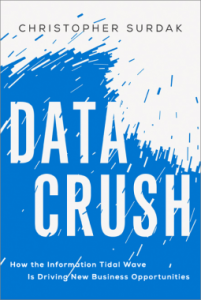Data Crush gives you the lowdown on what data abundance means for businesses. Access to unlimited data has proven most beneficial to businesses that found ways to capture and analyze it.
Data was always important, but its fascination was limited to the academia and social researchers who spent hours conducting polls and surveys. Now that the Internet has made it easy to track people’s actions without letting them know and without wasting their time, collecting data has become much easier. Recent years have brought focus on big data as open social media streams along with government’s open data efforts have enabled researchers and entrepreneurs to analyze people’s thoughts and opinions.
Christopher Surdak is an Information Technology veteran with 20+ years of experience in formulating strategy and information management. Currently, he helps Fortune 500 companies design and implement enterprise-level information management systems. He has held similar positions at Dell and Siemens before joining Accenture.
Title: Data Crush: How the Information Tidal Wave is Driving New Business Opportunities
Author: Christopher Surdak
Pub Date: February 2014
ISBN: 9780814433744
Page Count: 288
Book Review
Part I of the book, What’s Driving the Data Crush, covers the basics as the author explains the various behavioral and technological developments that make data availability possible. The author then moves to the real reason why data matters. In Part 2, The Impact on Business, covers how businesses can use these developments to capture crucial data from their customers and the infrastructure that they need to have in place. Finally in Part 3, How Successful Businesses Will Respond, the author explains how businesses can use these data to accrue the benefits from data abundance.
The author takes a very logical approach to making his point by first introducing the reader to the background knowledge as well as providing statistics to prove his assertions about the trends that are contributing to data crush. In each of the initial chapters that focus on explaining the data sources, the author provides information on how the trend developed and why it is there to stay and grow. The author first convinces you that there are tons of data generated each year and that the trend is here for the good. This makes data a must-have part of every business’ toolkit, if it isn’t already.
For example, in chapter 1, Mobility, the author points to the fact that almost everyone now has a mobile and is connected to the Internet at all times. This ubiquity of mobile devices and its ability to make things easier with apps helps create tons of data when people search, tweet, or check-in via networks like Foursquare. He believes that by 2020 people will live in a ‘Smart World’ where devices will exchange more messages than humans. The glimpse in the future and extrapolation is too great to retain, but the author summarizes the main points at the end of the chapter.
Similarly, the author outlines other trends such as digital commerce and Cloud computing in part 1. Well, you have tons of data and it is important, but how can you use these data and is this what people call Big Data? Chapter 6, Big Data: learning From the Flood, helps you clear these basic doubts as the author unravels the terminology in simple language using common metaphors. He shows how data analysis helps by using everyday examples when he discusses consumption from vending machines in a certain area or during a certain time to manage inventory, or a very creepy example of how Target can know things about you before you share it with your closest friend or family.
Chapter 7-9 talk about how mobile devices have provided advertisers with a context. Your mobile devices are constantly beeping your location. Combining this information with your shopping habits derived from other data sources and behavior on the social networking sites gives retailers the perfect scenario to push the right information at the right time.
Part 3 of the book highlights the difference between successful businesses and those that will be left behind. After discussing the changes in business processes in chapters 10, 11, and 12, chapter 13, Polarize, begins with introduction to six steps that the author believes will help businesses survive the data crush.
In the chapters to follow, the author outlines how businesses should define their strategy and focus their use of data. He puts a lot of thrust on reducing the business process cycle time, as speed will be the deciding factor in the next decade. He also discusses different strategies to achieve these objectives. In chapter 15, Data Enable, the author points out that the data created by business operation will increase manifold in the next decade and will be increasingly difficult to manage. In this scenario, identifying the important metrics and providing a holistic view of business will become important to decision making.
In conclusion, Data Crush is an excellent resource to understand Big Data and know how it is impacting businesses. The projections made by the author, although astonishing, are not unrealistic. Knowing these trends and the movement in business environment is essential for every business. Apart form business owners and managers, the book provides enough ideas and information for entrepreneurs to use data to create new solutions and applications for the information hungry market.
